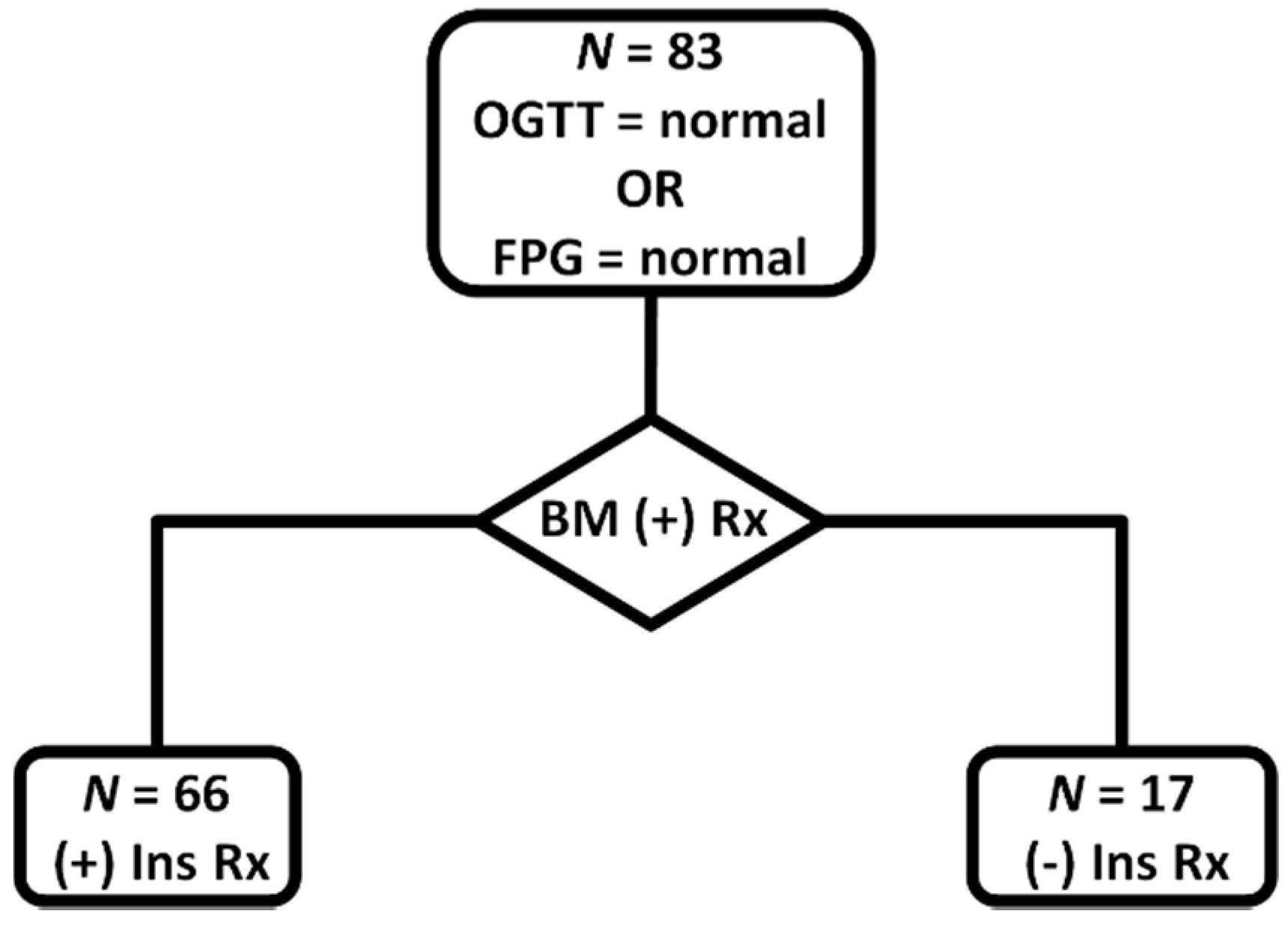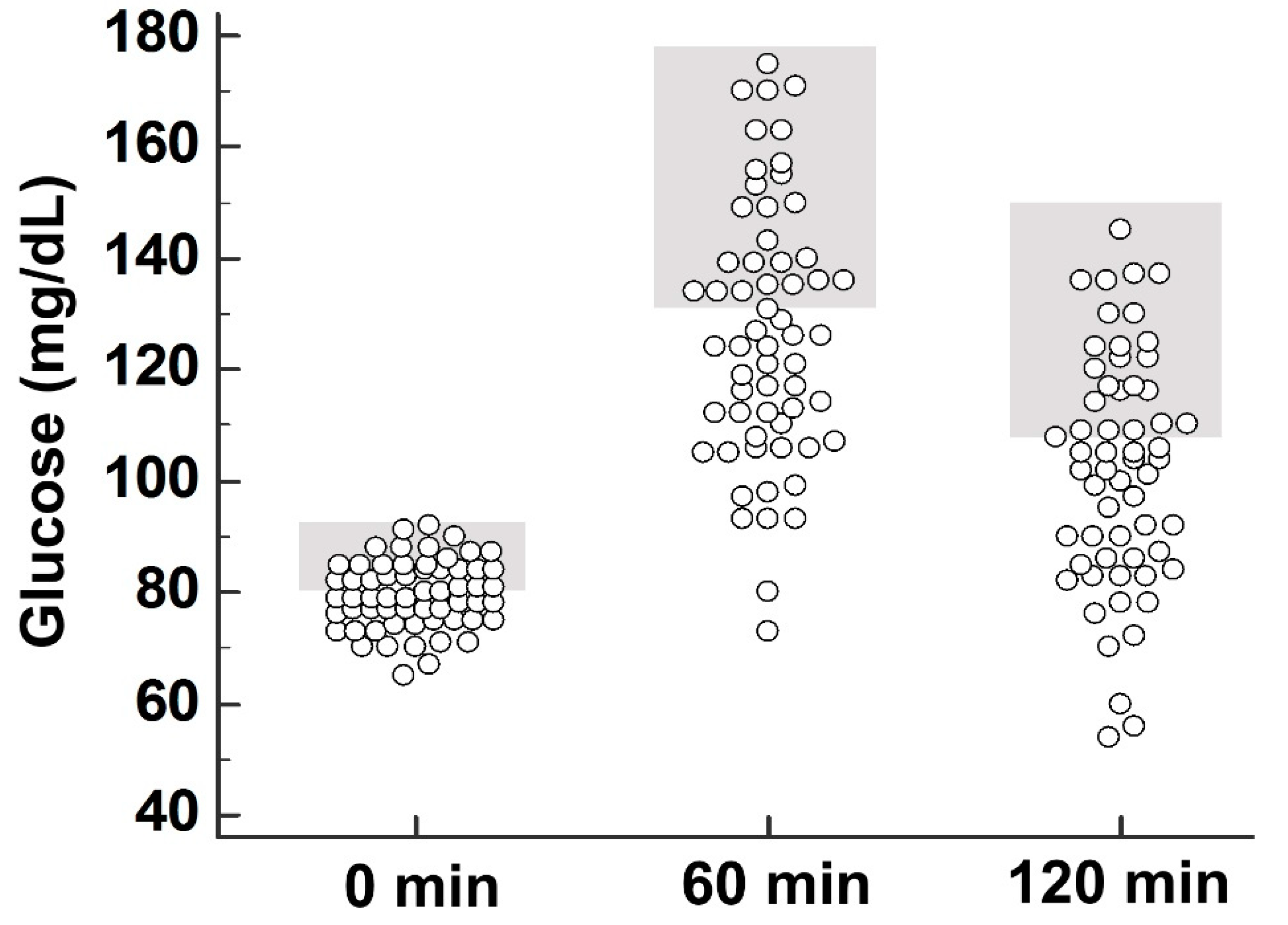Glycemia after Betamethasone in Pregnant Women without Diabetes—Impact of Marginal Values in the 75-g OGTT
Abstract
1. Introduction
2. Materials and Methods
3. Results
4. Discussion
5. Conclusions
Author Contributions
Funding
Conflicts of Interest
References
- Lee, M.J.; Guinn, D. Antenatal Corticosteroid Therapy for Reduction of Neonatal Morbidity and Mortality from Preterm Delivery. Available online: http://www.uptodate.com (accessed on 24 August 2015).
- Saccone, G.; Berghella, V. Antenatal corticosteroids for maturity of term or near term fetuses: Systematic review and meta-analysis of randomized controlled trials. BMJ 2016, 355, i5044. [Google Scholar] [CrossRef] [PubMed]
- Antenatal Corticosteroid Therapy for Fetal Maturation. Committee Opinion No.713: American College of Obstetricians and Gynecologists. Obstet. Gynecol. 2017, 130, e102–e109. [Google Scholar]
- FIGO Working Group on Good Clinical Practice in Maternal-Fetal Medicine. Good clinical practice advice: Antenatal corticosteroids for fetal lung maturation. Int. J. Gynaecol. Obstet. 2019, 144, 352–355. [Google Scholar] [CrossRef] [PubMed]
- Schmitz, T. Prevention of complications of prematurity by the prenatal administration of corticoids. J. Gynecol. Obstet. Biol. Reprod. 2016, 10, 1399–1417. [Google Scholar] [CrossRef] [PubMed]
- Kemp, M.W.; Newnham, J.P.; Challis, J.G.; Jobe, A.H.; Stock, S.J. The clinical use of corticosteroids in pregnancy. Hum. Reprod. Update 2016, 22, 240–259. [Google Scholar] [CrossRef] [PubMed]
- Itoh, A.; Saisho, Y.; Miyakoshi, K.; Fukutake, M.; Kasuga, Y.; Ochiai, D.; Matsumoto, T.; Tanaka, M.; Itoh, H. Time-dependent changes in insulin requirement for maternal glycemic control during antenatal corticosteroid therapy in women with gestational diabetes: A retrospective study. Endocr. J. 2016, 63, 101–104. [Google Scholar] [CrossRef] [PubMed]
- Kalra, S.; Kalra, B.; Gupta, Y. Glycemic management after antenatal corticosteroid therapy. N. Am. J. Med. Sci. 2014, 6, 71–76. [Google Scholar] [CrossRef] [PubMed]
- Amiya, R.M.; Mlunde, L.B.; Ota, E.; Swa, T.; Oladapo, O.T.; Mori, R. Antenatal Corticosteroids for Reducing Adverse Maternal and Child Outcomes in Special Populations of Women at Risk of Imminent Preterm Birth: A Systematic Review and Meta-Analysis. PLoS ONE 2016, 11, e0147604. [Google Scholar] [CrossRef] [PubMed]
- Jolley, J.A.; Rajan, P.V.; Petersen, R.; Fong, A.; Wing, D.A. Effect of antenatal betamethasone on blood glucose levels in women with and without diabetes. Diabetes Res. Clin. Pract. 2016, 118, 98–104. [Google Scholar] [CrossRef] [PubMed]
- Dashora, U.; Murphy, H.R.; Temple, R.C.; Stanley, K.P.; Castro, E.; George, S.; Dhatariya, K.; Haq, M.; Sampson, M.; Joint British Diabetes Societies (JBDS) for Inpatient Care. Managing hyperglycaemia during antenatal steroid administration, labour and birth in pregnant women with diabetes. Diabet. Med. 2018, 35, 1005–1010. [Google Scholar] [CrossRef] [PubMed]
- Star, J.; Hogan, J.; Burke Sosa, M.E.; Carpenter, M.W. Glucocorticoid associated maternal hyperglycemia: A randomized trial of insulin prophylaxis. J. Matern. Fetal. Neonatal. Med. 2000, 9, 273–277. [Google Scholar] [CrossRef]
- Haviv, H.R.; Said, J.; Mol, B.W. The place of antenatal corticosteroids in late preterm and early term births. Semin. Fetal. Neonatal. Med. 2019, 24, 37–42. [Google Scholar] [CrossRef] [PubMed]
- Falah, N.; Haas, D.M. Antenatal corticosteroid therapy: Current strategies and identifying mediators and markers for response. Semin. Perinatol. 2014, 38, 528–533. [Google Scholar] [CrossRef] [PubMed]
- Romejko-Wolniewicz, E.; Teliga-Czajkowska, J.; Czajkowski, K. Antenatal steroids: Can we optimize the dose? Curr. Opin. Obstet. Gynecol. 2014, 26, 77–82. [Google Scholar] [CrossRef] [PubMed]
- Kakoulidis, I.; Ilias, I.; Linardi, A.; Milionis, C.; Michou, A.; Koukkou, E. Glycemic profile assessment during betamethasone administration in women with gestational diabetes mellitus. Diabetes Metab. Syndr. 2019, 13, 214–215. [Google Scholar] [CrossRef] [PubMed]
- Refuerzo, J.S.; Garg, A.; Rech, B.; Ramin, S.M.; Vidaeff, A.; Blackwell, S.C. Continuous glucose monitoring in diabetic women following antenatal corticosteroid therapy: A pilot study. Am. J. Perinatol. 2012, 29, 335–338. [Google Scholar] [CrossRef] [PubMed]
- American Diabetes Association. Management of diabetes in pregnancy. Diabetes Care 2016, 39, S94–S98. [Google Scholar] [CrossRef] [PubMed]
- Berger, H.; Gagnon, R.; Sermer, M.; Basso, M.; Bos, H.; Brown, R.N.; Bujold, E.; Cooper, S.L.; Gagnon, R.; Gouin, K.; et al. Diabetes in Pregnancy. J. Obstet. Gynaecol. Can. 2016, 38, 667–679. [Google Scholar] [CrossRef] [PubMed]
- HAPO Study Cooperative Research Group. Hyperglycemia and adverse pregnancy outcomes. N. Engl. J. Med. 2008, 358, 1991–2002. [Google Scholar] [CrossRef] [PubMed]
- Gong, L.L.; Liu, H.; Liu, L.H. Relationship between hypothyroidism and the incidence of gestational diabetes: A meta-analysis. Taiwan J. Obstet. Gynecol. 2016, 55, 171–175. [Google Scholar] [CrossRef]


© 2020 by the authors. Licensee MDPI, Basel, Switzerland. This article is an open access article distributed under the terms and conditions of the Creative Commons Attribution (CC BY) license (http://creativecommons.org/licenses/by/4.0/).
Share and Cite
Kakoulidis, I.; Ilias, I.; Linardi, A.; Michou, A.; Milionis, C.; Petychaki, F.; Venaki, E.; Koukkou, E. Glycemia after Betamethasone in Pregnant Women without Diabetes—Impact of Marginal Values in the 75-g OGTT. Healthcare 2020, 8, 40. https://doi.org/10.3390/healthcare8010040
Kakoulidis I, Ilias I, Linardi A, Michou A, Milionis C, Petychaki F, Venaki E, Koukkou E. Glycemia after Betamethasone in Pregnant Women without Diabetes—Impact of Marginal Values in the 75-g OGTT. Healthcare. 2020; 8(1):40. https://doi.org/10.3390/healthcare8010040
Chicago/Turabian StyleKakoulidis, Ioannis, Ioannis Ilias, Anastasia Linardi, Aikaterini Michou, Charalampos Milionis, Foteini Petychaki, Evangelia Venaki, and Eftychia Koukkou. 2020. "Glycemia after Betamethasone in Pregnant Women without Diabetes—Impact of Marginal Values in the 75-g OGTT" Healthcare 8, no. 1: 40. https://doi.org/10.3390/healthcare8010040
APA StyleKakoulidis, I., Ilias, I., Linardi, A., Michou, A., Milionis, C., Petychaki, F., Venaki, E., & Koukkou, E. (2020). Glycemia after Betamethasone in Pregnant Women without Diabetes—Impact of Marginal Values in the 75-g OGTT. Healthcare, 8(1), 40. https://doi.org/10.3390/healthcare8010040





